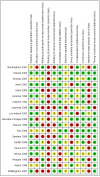Is manipulative therapy more effective than sham manipulation in adults : a systematic review and meta-analysis
- PMID: 24274314
- PMCID: PMC3850908
- DOI: 10.1186/2045-709X-21-34
Is manipulative therapy more effective than sham manipulation in adults : a systematic review and meta-analysis
Abstract
Background: Manipulative therapy is widely used in the treatment of spinal disorders. Manipulative techniques are under debate because of the possibility of adverse events. To date, the efficacy of manipulations compared to sham manipulations is unclear. The purpose of the study is: to assess the efficacy of manipulative therapy compared to sham in adults with a variety of complaints.
Study design: Systematic review and meta-analysis.
Methods: Bibliographic databases (PubMed, EMBASE, CINAHL, PEDro, Central) along with a hand search of selected bibliographies were searched from inception up to April 2012.
Results: In total 965 references were screened for eligibility and 19 RCTs (n = 1080) met the selection criteria. Eight studies were considered of low risk of bias. There is moderate level of evidence that manipulative therapy has a significant effect in adults on pain relief immediately after treatment (standardized mean difference [SMD] - 0.68, 95% confidence interval (-1.06 to -0.31). There is low level of evidence that manipulative therapy has a significant effect in adults on pain relief (SMD - 0.37, -0.69 to -0.04) at short- term follow-up. In patients with musculoskeletal disorders, we found moderate level of evidence for pain relief (SMD - 0.73, -1.21 to -0.25) immediate after treatment and low level of evidence for pain relief (SMD - 0.52, -0.87 to -0.17) at short term-follow-up. We found very low level of evidence that manipulative therapy has no statistically significant effect on disability and perceived (asthma) recovery. Sensitivity analyses did not change the main findings. No serious adverse events were reported in the manipulative therapy or sham group.
Conclusions: Manipulative therapy has a clinical relevant effect on pain, but not on disability or perceived (asthma) recovery. Clinicians can refer patients for manipulative therapy to reduce pain.
Figures





References
LinkOut - more resources
Full Text Sources
Other Literature Sources
Miscellaneous

